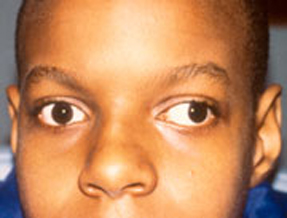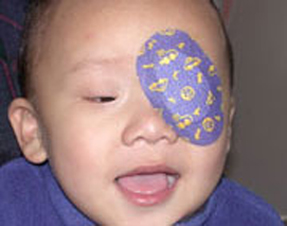
Strabismus is a visual problem in which the eyes are not aligned properly and point in different directions. One eye may look straight ahead, while the other eye turns inward, outward, upward, or downward. The eye turn may be consistent, or it may come and go. Which eye is straight (and which is misaligned) may switch or alternate.
Strabismus is a common condition among children. About 4 percent of all children in the United States have strabismus. It can also occur later in life. It may run in families; however, many people with strabismus have no relatives with the problem.
Infantile esotropia, where the eye turns inward, is a common type of strabismus in infants. Young children with esotropia cannot use their eyes together. Accommodative esotropia is the most common form of esotropia that occurs in children usually 2 years or older. In this type of strabismus, when the child focuses the eyes to see clearly, the eyes turn inward. This crossing may occur when focusing at a distance, up close or both.

Exotropia. Notice the outward-turning eye.
Exotropia, or an outward turning eye, is another common type of strabismus. This occurs most often when a child is focusing on distant objects. The exotropia may occur only from time to time, particularly when a child is daydreaming, ill or tired. Parents often notice that the child squints one eye in bright sunlight.
Six eye muscles, controlling eye movement, are attached to the outside of each eye. In each eye, one muscle moves in the eye to the right, and one muscle moves the eye to the left. The other four muscles move it up or down and at an angle. To line up and focus both eyes on a single target, all of the muscles in each eye must be balanced and working together. In order for the eyes to move together, the muscles in both eyes must be coordinated. The brain controls these muscles.
With normal vision, both eyes aim at the same spot. The brain then combines the two pictures into a single, three-dimensional image. This three-dimensional image gives us depth perception. When one eye is out of alignment, two different pictures are sent to the brain. In a young child, the brain learns to ignore the image of the misaligned eye and sees only the image from the straight or better-seeing eye. The child then loses depth perception. Adults who develop strabismus often have double vision because their brains have already learned to receive images from both eyes and cannot ignore the image from the turned eye. A child generally does not see double.
Strabismus is especially common among children with disorders that may affect the brain, such as:
A cataract or eye injury that affects vision can also cause strabismus. The vast majority of children with strabismus, however, have none of these problems. Many do have a family history of strabismus.

Good vision develops during childhood when both eyes have normal alignment. Strabismus may cause reduced vision, or amblyopia, in the misaligned eye. The brain will pay attention to the image of the straight eye and ignore the image of the crossed eye. If the same eye is consistently ignored during early childhood, this misaligned eye may fail to develop a good vision, or may even lose vision. Strabismic amblyopia occurs in approximately half of the children who have strabismus.
Amblyopia can be treated by patching or blurring the stronger eye to strengthen and improve vision in the weaker eye. If amblyopia is detected in the first few years of life, treatment is usually successful. If treatment is delayed, amblyopia may become permanent. As a rule, the earlier amblyopia is treated, the better the result for vision.
Treatment for strabismus works to straighten the eyes and restore binocular (two-eyed) vision. In some cases of strabismus, eyeglasses can be prescribed for your child to straighten the eyes. Other treatments may involve surgery to correct the unbalanced eye muscles or to remove a cataract. Patching or blurring the strong eye to improve amblyopia is often necessary. Very young children with esotropia usually require surgery to realign the eyes. For accommodative esotropia, glasses reduce the focusing effort and often straighten the eyes. Sometimes bifocals are needed for close work. If significant crossing of the eyes persists with the glasses, surgery may be required. With exotropia, though glasses, exercises, patching or prisms may reduce or help control outward-turning of the eye in some children, surgery is often needed.
The eyeball is never removed from the socket during any kind of surgery. The ophthalmologist makes a small incision in the tissue covering the eye to reach the eye muscles. The eye muscles are detached from the wall of the eye and repositioned during the surgery, depending on which direction the eye is turning. It may be necessary to perform surgery on one or both eyes. Recovery time is rapid. Children are usually able to resume their normal activities within a few days. After surgery, glasses may still be required. In some cases, more than one surgery may be needed to straighten the eyes.